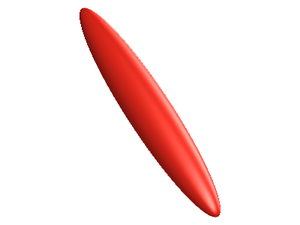 A prolate ellipsoid.
A prolate ellipsoid.
Interaction Potential
The general ellipsoid, also called a triaxial ellipsoid, is a quadratic surface which is given in Cartesian coordinates by

where  ,
,  and
and  define the lengths of the
axis.
define the lengths of the
axis.
Overlap algorithm
The most widely used overlap algorithm is that of Perram and Wertheim:
Geometric properties
The mean radius of curvature is given by (Refs. 5 and 6)
![{\displaystyle R={\frac {a}{2}}\left[{\sqrt {\frac {1+\epsilon _{b}}{1+\epsilon _{c}}}}+{\sqrt {\epsilon }}_{c}\left\{{\frac {1}{\epsilon _{c}}}F(\varphi ,k_{1})+E(\varphi ,k_{1})\right\}\right],}](https://wikimedia.org/api/rest_v1/media/math/render/svg/4e881e50476a138c1b82d0eff3fa835b1212160d)
and the surface area is given by
![{\displaystyle S=2\pi a^{2}\left[1+{\sqrt {\epsilon _{c}(1+\epsilon _{b})}}\left\{{\frac {1}{\epsilon _{c}}}F(\varphi ,k_{2})+E(\varphi ,k_{2})\right\}\right],}](https://wikimedia.org/api/rest_v1/media/math/render/svg/0a0370210651aa0d817cf6bd9f11fc9898f4a23b)
where  is an elliptic integral of the first kind and
is an elliptic integral of the first kind and  is an elliptic integral of the second kind,
with the amplitude being
is an elliptic integral of the second kind,
with the amplitude being

and the moduli

and

where the anisotropy parameters,  and
and  , are
, are

and

The volume of the ellipsoid is given by the well known

Mathematica notebook file for calculating the surface area and mean radius of curvature of an ellipsoid
See also
References
- D. Frenkel and B. M. Mulder "The hard ellipsoid-of-revolution fluid I. Monte Carlo simulations", Molecular Physics 55 pp. 1171-1192 (1985)
- Michael P. Allen "Computer simulation of a biaxial liquid crystal", Liquid Crystals 8 pp. 499-511 (1990)
- Philip J. Camp and Michael P. Allen "Phase diagram of the hard biaxial ellipsoid fluid", Journal of Chemical Physics 106 pp. 6681- (1997)
- Carl McBride and Enrique Lomba "Hard biaxial ellipsoids revisited: Numerical results", Fluid Phase Equilibria 255 pp. 37-45 (2007)
- G. S. Singh and B. Kumar "Geometry of hard ellipsoidal fluids and their virial coefficients", Journal of Chemical Physics 105 pp. 2429-2435 (1996)
- G. S. Singh and B. Kumar "Molecular Fluids and Liquid Crystals in Convex-Body Coordinate Systems", Annals of Physics 294 pp. 24-47 (2001)





![{\displaystyle R={\frac {a}{2}}\left[{\sqrt {\frac {1+\epsilon _{b}}{1+\epsilon _{c}}}}+{\sqrt {\epsilon }}_{c}\left\{{\frac {1}{\epsilon _{c}}}F(\varphi ,k_{1})+E(\varphi ,k_{1})\right\}\right],}](https://wikimedia.org/api/rest_v1/media/math/render/svg/4e881e50476a138c1b82d0eff3fa835b1212160d)
![{\displaystyle S=2\pi a^{2}\left[1+{\sqrt {\epsilon _{c}(1+\epsilon _{b})}}\left\{{\frac {1}{\epsilon _{c}}}F(\varphi ,k_{2})+E(\varphi ,k_{2})\right\}\right],}](https://wikimedia.org/api/rest_v1/media/math/render/svg/0a0370210651aa0d817cf6bd9f11fc9898f4a23b)









